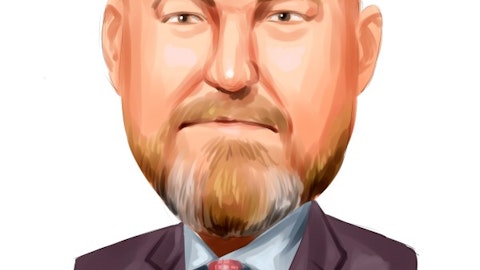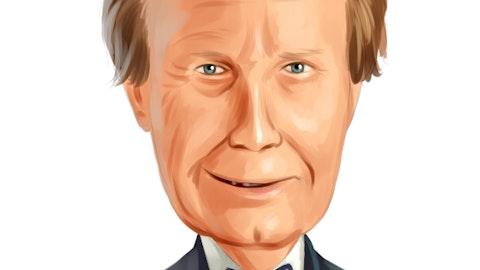Hilltop Holdings Inc. (NYSE:HTH) Q4 2022 Earnings Call Transcript January 27, 2023
Operator: Hi, everyone, and welcome to the Hilltop Holdings’ Fourth Quarter 2022 Earnings Conference Call and Webcast. My name is Bruno, and I will be the operator of your call today. I will now hand over to your host, Erik Yohe. Please go ahead.
Erik Yohe: Thank you, Bruno. Before we get started, please note that certain statements during today’s presentation that are not statements of historical fact, including statements concerning such items as our outlook, business strategy, future plans, financial condition, allowance for credit losses, the impact and potential impacts of inflation, stock repurchases and dividends and impacts of interest rate changes, as well as such other items referenced in the preface of our presentation are forward-looking statements. These statements are based on management’s current expectations concerning future events that, by their nature, are subject to risks and uncertainties. Our actual results, capital, liquidity, and financial condition may differ materially from these statements due to a variety of factors, including the precautionary statements referenced in our presentation and those included in our most recent annual and quarterly reports filed with the SEC.
Please note that the information presented is preliminary and based upon data available at this time. Except to the extent required by law, we expressly disclaim any obligation to update earlier statements as a result of new information. Additionally, this presentation includes certain non-GAAP measures, including tangible common equity and tangible book value per share. A reconciliation of these measures to the nearest GAAP measure may be found in the appendix to this presentation, which is posted on our Web site at ir.hilltop-holdings.com. With that, I will now turn the presentation over to President and CEO, Jeremy Ford.
Jeremy Ford: Thank you, Erik, and good morning. For the fourth quarter, Hilltop reported net income of approximately $26 million or $0.39 per diluted share. Return on average assets for the period was 0.6%, and return on average equity was 5%. Although the mortgage market remained under significant pressure, we still generated consolidated profitability, and grew our capital base due to our diversified business model, strong balance sheet, and continued focus on expense discipline across each of our companies. During the fourth quarter, PlainsCapital Bank generated $58 million in pretax income, and a strong return on average assets of 1.3%. Though pretax income is down year-over-year due to changes in provision expense from deterioration of the economic outlook, the bank’s pre-tax pre-provision income grew materially from net interest income expansion and a relatively flat expense base despite the inflationary environment.
Average loans held for investment at PlainsCapital Bank increased $101 million or approximately 4% annualized in the quarter as a result of both core commercial loans and an increase in retained mortgage balances. Average loan growth would have been higher if not for the approximate $116 million decline in average national warehouse lending balances versus the prior quarter, which has been impacted by the shrinking mortgage market. We are pleased with the loan growth in 2022; however we are starting to see pressure on the pipeline as a result of our heightened credit standards and declining loan demand in general due to the economy, elevated rates, and other factors. Total average deposits decreased by $270 million or 2% quarter-over-quarter as customers have migrated deposit balances towards higher-yielding assets, both inside and outside of the bank.
We are pleased that we have been meaningful deposit relationships within our private bank’s assets under management as customers move some money from bank deposits into treasuries and similar securities. For the full-year, the bank generated $219 million in pre-tax income and a return on average assets of 1.2%. Net interest income before purchase accounting accretion and PPP income grew by $32 million or 9% as interest rates increased throughout the year. We do expect deposit balances and costs to be under pressure in 2023 due to intense competition across Texas where many banks will inevitably drive up market pricing for deposits to maintain liquidity. We continue to monitor credit closely in anticipation that economic conditions could result in a downward migration in asset quality.
That said, we currently do not show any significant signs of credit deterioration in our loan portfolio. Additionally, with elevated rates expected throughout 2023, we anticipate continuing to see borrowers putting higher amounts of equity into transactions and projects continuing to slow. Overall, we are extremely pleased with PlainsCapital Bank’s results in 2022, and remain optimistic for the banking environment in 2023. We have a great group of leaders and bankers across Texas, and we’ll continue to capitalize on the growth in strong economies within our start. Moving to PrimeLending, during the fourth quarter, PrimeLending experienced a loss before taxes of approximately $26 million on $2 billion of originated volume. This was driven by a 59% decline in volume and a 151 basis point reduction in gain on sale margin from the same period prior year.
There were multiple factors that adversely impacted the mortgage industry in 2022, including inflation, the resulting steep rise in interest rates, limited housing inventory, and the negative residual impacts of the COVID-19 pandemic. These factors have constrained the willingness and ability of prospective home-buyers and existing home owners to conduct mortgage transactions, both in the purchase and refinancing markets. Additionally, these trends have added to already competitive mortgage pricing pressures, leading to a decline in average loan sales margins as mortgage volume declines have materially outpaced the capacity that needs to come out of the mortgage origination ecosystem. Throughout the challenging year, our team has remained resilient and undertook difficult but impactful cost reduction and optimization actions to help resize the overall business, specifically reducing non-originator headcount by approximately 515 people or 37% during the year.
That said, our PrimeLending leadership team remains focused on their two primary objectives, originating profitable loans and continuing to operate the business more efficiently. During the quarter, HilltopSecurities generated pre-tax income of $19.8 million on net revenues of $107 million, an increase in revenues of $12 million or 13% compared to Q4, 2021. The revenue increase was primarily driven by fixed income services, which more than offset a slow quarter in public finance as national issuance declined by 41% compared to Q4, 2021. Increased revenues from fixed income can be attributed primarily to improvements in municipal and mortgage products. Additionally, our revenue from sweep deposits continues to improve, so we expect the growth in that revenue to moderate in 2023.
For the year, HilltopSecurities generated net revenues of $394 million and a pre-tax margin of 9.6%. Financial results improved over the last three consecutive quarters following very volatile trading results in the first quarter. Moving the page forth, Hilltop maintained strong capital levels, with a common equity Tier 1 capital ratio of 18.2%, and tangible book value per share of $27.31 at year-end. During 2022, Hilltop returned $485 million to shareholders through dividends and share repurchase efforts, repurchasing approximately 19% of the shares outstanding one year ago. This week, Hilltop’s Board of Directors declared a quarterly cash dividend of $0.16 per common share, a 7% increase from the prior quarter, and authorized a new stock repurchase program of $75 million, through January 2024.
Overall, 2022 was a challenging year for our mortgage-related businesses though buoyed by the strength of our banking franchise. Despite challenges in certain business lines, we feel that we have positioned the organization well entering 2023. First, our financial position is solid. We have a strong balance sheet with ample liquidity, diversified and accessible funding sources, and an outsized capital base. We believe this allows us to invest in our business, stay resilient through unknown economic cycles, and take advantage of growth opportunities as they arise. Second, we have worked to enhance productivity and expense efficiency across all business and, in particular, executed on significant actions within our mortgage operations groups to better align with the current market.

Photo by Cytonn Photography on Unsplash
Through those efforts, we are expecting a more efficient expense base to help combat rising inflation costs. And we are poised to benefit from higher margins as the economy recovers. Additionally, employee engagement is high, and we feel that we are more focused and aligned as a company than ever before. In conclusion, we believe that 2023 will be a prosperous year for Hilltop. We have the solid foundation — excuse me, we have a solid financial foundation, well-established businesses, and solid teams across our franchise. We are excited about the opportunities that lie ahead are committed to delivering value to our shareholders. With that, I will now the presentation over to Will to discuss the financials.
William Furr: Thank you, Jeremy. I’ll start on page five. As Jeremy discussed for the fourth quarter of 2022, Hilltop reported consolidated income attributable to common stockholders of $26 million equating to $0.39 per diluted share. As shown on page six, for the full-year 2022, Hilltop reported consolidated income attributable to common stock holdings of $113 million or a $1.60 per diluted share. Of note, Hilltop’s outstanding shares will reduce by 18% or 14.3 million shares during the year primarily as a result of the successful 10-year offer completed during May. Turning to page seven, Hilltop’s allowance for credit losses increased by $3.6 million to $95.4 million as deterioration in the macroeconomic outlook drove a modest increase in the ACL.
The economic impact was somewhat offset by reductions in both specific reverses and collective portfolio migration. Allowance for credit losses of $95 million yields an ACL to total loans HFI ratio of 1.18% as of yearend 2022. Of note, we continue to believe that the allowance for credit losses could be volatile and the future changes in allowance will be driven by net loan growth in the portfolio, credit migration trends, and changes to the macroeconomic outlook over time. Given the current uncertainties regarding inflation, interest rates, the future outlook for GDP growth, and unemployment changes in the ACL on a quarterly basis could be volatile. I am turning to page eight. Net interest income in the fourth quarter equated to a $123 million including $2.2 million of purchase accounting accretion.
Versus the prior year quarter, net income increased by $19 million or 18% driven primarily by higher yields on loans, securities, and cash balances which was somewhat offset by higher rates on deposits and variable rate borrowings. And interest margin continued to improve versus the third quarter of ’22 increasing by 4 basis points to 323 basis points. Our current outlook reflects a scenario whereby fed funds moves to between 5% and 5.25% during the first half of 2023 and remained stable for the balance of the year. If this scenario proves to be accurate, we expect NII and NIM to continue to expand modestly through the first half of the year. And then began to decline as the interest-bearing deposit rates will likely continue to move higher throughout the balance of 2023 as the competitive environment for liquidity remains very intense.
Turning to page nine, in the chart we highlight the asset sensitivity of Hilltop assuming parallel and instantaneous rate shocks which represents an asset sensitive position of approximately 6% in the up 100% basis point scenario. As we evaluate asset sensitivity and the interest rate risk, we assess a number of potential scenarios. Of note, we shift the analysis from instantaneous parallel shift to a gradual increase over the course of the next 12 months, the up 100 basis point sensitivity falls through approximately 3%. Further in this scenario, each 25 basis point increase positively impacts net interest income by approximately $4 million. Moving to page 10, total non-interest income for the fourth quarter of 2022 equated to $170 million.
Fourth quarter mortgage-related income and fees decreased by $121 million versus the fourth quarter of ’21 driven by the evolving environment in mortgage making which remains very challenged in combination of higher interest rates, home price inflation, limited housing supply, and ongoing overcapacity in terms of mortgage originators across the United States has driven volumes materially lower and moved margins to levels we have not seen in the recent history. Further versus the prior year quarter, purchase mortgage volumes decreased by $1.7 billion or 47% and refinanced volumes decreased by $1.3 billion or 90%. During the fourth quarter of 2022, gains-on-sale margins continued what has been a multi-quarter decline with gain-on-sales margins for loans sold to third parties declining 16 basis points to 211 basis points.
Our gain on sale margins have been pressured, we are continuing to see the customers are paying to buy down their interest rate. And as such, our mortgage regions are stable versus the prior-year period. We expect the gain on sale margins will continue to be pressured and trend lower throughout the first half of the year, and customers will continue to prefer to buy down their interest rate rather than probate — rather than pay the prevailing market rate, resulting in mortgage origination fees continuing to outperform origination volume trends. Other income increased by $18 million driven primarily by improved municipal trading results, and additional favorable valuation marks across the fixed income trading books during the quarter. It is important to recognize that most of fixed income services and structured finance businesses, HilltopSecurities can be volatile from period-to-period, as they are impacted by interest rates, overall market liquidity, volatility and production trends.
I’m turning to page 11. Non-interest expenses decreased from the same period in the prior-year by $69 million to $253 million. The decline in expenses versus the prior-year was driven by decreases in variable compensation of approximately $50 million at HilltopSecurities and PrimeLending, which was linked to lower fee revenue generation in the quarter compared to the prior-year period. Additionally, non-compensation variable expenses, particularly mortgage production related expenses, which are captured in other expenses in the table in the upper right of the slide, declined as production volumes declined versus the prior-year. Looking forward to 2023, we expect expenses other than variable compensation will remain relatively stable as the ongoing focused efforts relating to streamlining our operations and improving productivity, continue to support lower headcount and improve throughput across our franchise.
Moving to page 12; fourth quarter average HFI loans equated to $7.8 billion in 2022 stable with the prior-year fourth quarter levels. On a period ending basis, HFI loans grew versus the third quarter of ’22 by $213 million driven by improving commercial loan growth, particularly in commercial real estate, and the retention of one to four family mortgages originated by PrimeLending. During the fourth quarter of 2022, PrimeLending locked approximately $142 million of loans to be delivered to PlainsCapital over the coming months. These loans had an average yield of 617 basis points, and average FICO and LTVs of 774 and 68% respectively. Turning to page 13; in the graph in the upper right, we show the progress made in reducing NPAs throughout 2022, which continued to support a relatively low level of net charge-offs throughout the fiscal year.
As is shown on the graph, the bottom right of the page, the allowance for credit loss coverage at the bank ended 2022 and 1.24%, including mortgage warehouse lending. I’m moving to page 14. Fourth quarter average total deposits are approximately $11.4 billion and declined by approximately $1 billion, or 8% versus the fourth quarter of ’21. On an ending balance basis, deposits declined by $1.5 billion to $11.3 billion from the prior-year ending level, including the decline was our usage of $442 million related to the HTH tender share repurchase and $410 million of deposits that have transferred into our private bank in pursuit of higher yields and treasuries or other suite programs. While we expected deposits to decline, given the level and speed of market interest rate adjustments, coupled with our decision to manage interest bearing deposit costs was a significant lag, during the fourth quarter of 2022, we began to see customer activity shift as customers began to seek higher interest rates at an accelerated pace.
Interest bearing deposit costs rose 157 basis points from 22 basis points in the prior-year period. Given the ongoing competitive intensity for liquidity by some participants in our markets, we expected deposit rates will continue to move higher throughout 2023 dropping our expected deposit date is above our previous target of 50% towards 60% through the cycle for interest bearing deposits. We remain focused on balancing our competitive position and supporting our long-term customer relationships with managing net interest income over time. Turning to page 15, as we turn the calendar to 2023, there continues to be a lot of uncertainty in the market regarding interest rates, inflation and the overall health of the economy. We’re pleased with the work that our team has delivered to position our company for times like these and our teammates across our franchise remain focused on delivering great customer service to our clients, attracting new customers to our franchise, supporting the communities where we serve, maintaining a moderate risk profile, and delivering long-term shareholder value.
As is noted in the table, our current outlook for 2023 reflects our current assessment of the economy and the markets where we participate. Further, as the market changes and we adjust our business to respond, we will provide updates to our outlook on our future quarterly calls. Operator, that concludes our prepared comments. We’ll turn the call back to you for the Q&A section of the call.
See also 15 Most Undervalued NASDAQ Stocks and 12 Cheap Bank Stocks To Buy.
Q&A Session
Follow Hilltop Holdings Inc. (NYSE:HTH)
Follow Hilltop Holdings Inc. (NYSE:HTH)
Operator: Our first question is from Michael Rose from Raymond James. Michael, your line is now open, please go ahead.
Michael Rose: Hey, good morning, guys. Hope you’re well. Thanks for taking my questions. Just wanted to talk about the Mortgage segment and I think you mentioned some of the steps you’ve taken to reduce the cost base. Can you just give a little bit more color on what steps you’ve taken to kind of right-size the business and how we should think about segment profitability, at least over the next couple quarters? Right now, it’s going to be pretty challenging, but just wanted to see if we’re kind of at or near an inflection point with the loss this quarter? Thanks.
William Furr: Hi, Michael, this is Will. Thanks for the question. I think as we have gone through 2022, a lot of work was done, as Jeremy mentioned, in the non-production area. We’ll continue to make investments in our originators, trying to grow our sales staff obviously. We’ve got to originate profitable loans to reach the inflection point you talked about. We’ve done significant reductions in the middle and back office to focus on productivity targets that had been set forth previously. We continue to make strides in that area, so we’re continuing to evaluate it. I’d say the realignment of that business is more of a process than a place where we just get to an endpoint. We’ll continue to evaluate the business on, really, a weekly basis — weekly and quarterly basis as we see production trends here in to the first quarter.
As it relates to profitability, we are expecting that the first quarter will yield results similar to those in the fourth quarter. First quarter is seasonally a weak origination period; nothing we’ve seen in the first month here has changed that view. However, in the second-half of the year, we expect to start to move closer to breakeven or profitability. So, the work the team’s done, I think, has positioned us to reach that inflection point. But again, we do expect a challenging first quarter.
Michael Rose: Perfect. Appreciate the color. And what — I know you talked about pressure on the gain on sale margin, but do you have a sense for how much either downward pressure there may be from here, or maybe when you think, might be the better question, when it might actually stabilize? I know we’ve talked about the excess capacity coming out of the system, but still seems like you and others are still seeing pressure. When do you think we kind of hit an inflection point there? And then could we actually start to see some relief as we move into the back-half of the year? Thanks.
William Furr: I think it’s hard to call. Obviously, we’re playing with the market — we’re playing in the market we’re given, so it’s hard to absolutely say. Our expectation just based on that return to breakeven or profitability relies on some relief from a gain on sale perspective as well as mortgage origination fees continuing to remain strong. So, we are projecting that it will start to improve in the second-half of the year. But again, it has taken longer and moved slower from a rightsizing of the overall industry than we would have otherwise expected. So, we’re going to continue to be vigilant around cost in rightsizing our franchise, and be focused on driving our businesses as best we can toward profitability.




